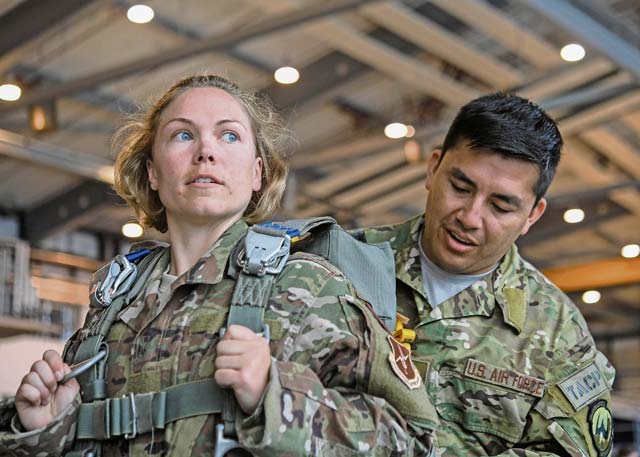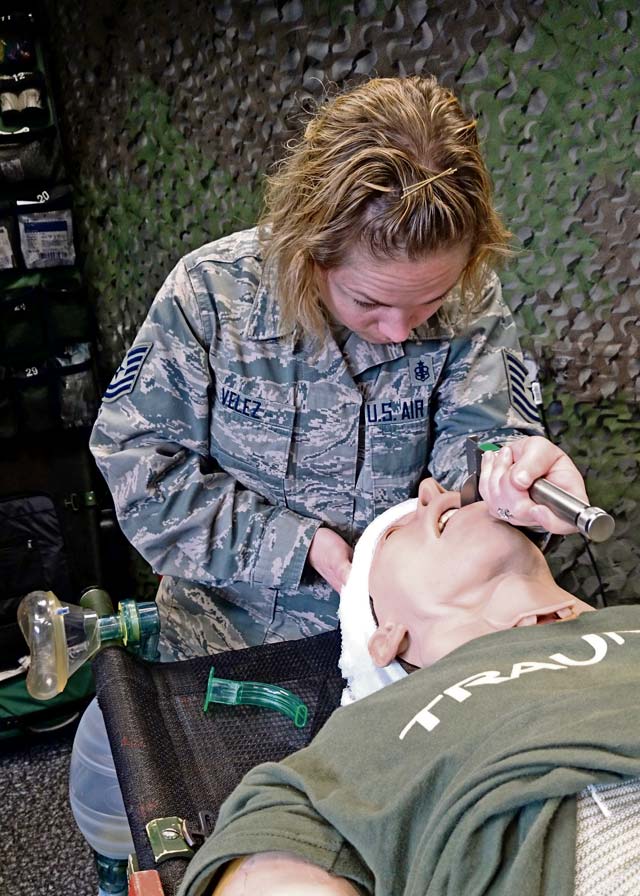
It’s hard to step outside of your comfort zone. Some people occasionally step outside of it, tentatively trying a new experience. Others, like Tech. Sgt. Cortney Velez, boldly jumps out of it from 1,250 feet above.
Velez, a 435th Contingency Response Support Squadron independent duty medical technician, became U.S. Air Forces in Europe’s first female airborne IDMT after completing her first jump with the 435 CRG, May 12 in Alzey, Germany.
Prior to graduating the U.S. Army’s Airborne School, she had never jumped from an aircraft. Wanting to try something different, Velez signed up to simply try something different.
“I knew accepting this job position would be stepping out of my comfort zone and pushing myself to my limits,” Velez said. “If you stay in that comfort zone, you start to get complacent, get stagnant. You’re not going to push yourself to that next level. Even though nobody wants to be uncomfortable, every time I’ve taken that leap, it’s always paid off.”
Velez is in one of only two airborne IDMT positions in the U.S. Air Force.
Maj. Erin Archer, 435 CRSS assistant director of operations, wasn’t surprised upon finding out about Velez’s completion of airborne school.
“Tech. Sgt Velez is not someone who is intimidated by challenges or the hard work required to overcome them,” Archer said. “The amount of time and effort she dedicated to prepare for the three-week Army training and her final success with this endeavor is truly inspiring. She is a competent and skilled IDMT, an exemplary Airman, and brings a positive attitude wherever she goes. She has a reputation in the CRG for setting an exceptionally high standard in all she achieves, and does so in a humble manner.”
An IDMT is best described as having a small medical group capability encompassed in one individual. They can assess, evaluate, diagnose and treat any active-duty member in the absence of a provider within their established protocols.
Some core functions IDMTs perform are emergency medicine, immunizations, bioenvironmental engineering, public health, and aerospace medicine in addition to laboratory, pharmaceutical and dental services.
Not only are IDMTs a jack of all trades, but Velez’s mission requires further specializations.
“When we go out on a mission, we’re not sitting on the sidelines waiting for our tent to get put up,” said Velez. “We’re setting up tents with the team. We are in there getting our hands dirty; we’re part of a team. We know them and their families, and they know us and our families. The IDMTs know almost every in and out of their job.”
Velez said because she’s embedded with the team and knows what they’re going through, if they become injured or sick, it gives her the ability to better administer treatment.
Amid encompassing a mobile diagnosis and treatment facility, a few of Velez’s duties within the 435 CRG also include entomology disease management and prevention, food sanitation inspections, hospital site surveys, instructing multiple combat medical care courses, operating heavy equipment, and providing sick-call capabilities to more than 1,200 personnel.
Velez has marked a first for USAFE’s history books, and though she thinks gender definitely played a part in some other people’s minds while she was running alongside her airborne-school teammates, it wasn’t a factor for her.
“I don’t feel like I ever gave anyone a chance to doubt me,” Velez said.
Velez continues to jump outside her comfort zone, descending into partner nations and persists to balance the tasks of multiple medics, maintaining healthy Airmen inside the CRG, one mission at a time.








